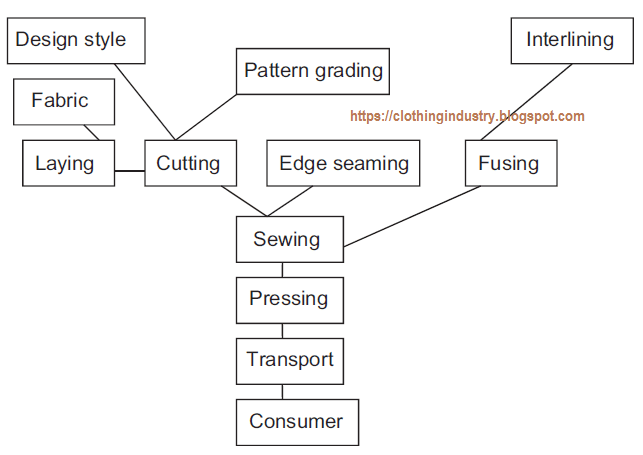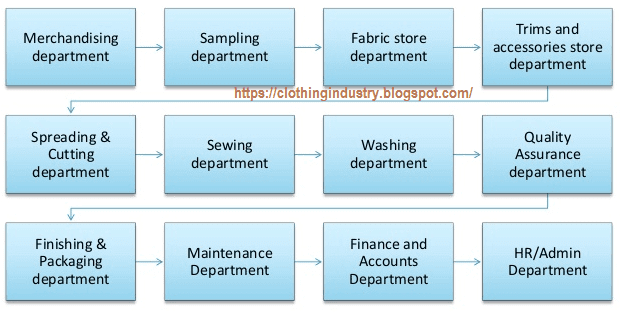Different Departments in Garment Industry
Garment technology is a broad based subject because it combines a number of individual technologies, with each making a specialized contribution to the production of garment. The apparel industry is very diverse in nature and along with textile industries, it forms a complex combination of performing heterogeneous functions of transforming fiber into yarn and then to fabric. It is one of the oldest and largest industry providing ample employment opportunities and it exemplifies the growth in global manufacturing. This industry is very versatile in nature and offers the world with a choice of garments ranging from mass market to high end fashion. This industry follows a combination of functional and line type of organization. Garment manufacturing process includes number of processes from order receiving to dispatching shipment of the finished garments. Apparel manufacturing flow chart helps understand a garment manufacturing method that how the raw materials are converted into the wearable garments. The main task for a garment manufacturer is to produce shell structures out of flat fabrics to match the shape of human body. The overall flowchart of the garment manufacturing process is illustrated in figure-1.
 |
| Figure-1: Flowchart of the garment manufacturing process |
Various Departments in the Apparel Industry:
Clothing or apparel industry consists of different departments. Every department is responsible for better production. The various departments working flowchart are given in figure-2:
 |
| Figure-2: Various garment departments working flowchart |
- Merchandising
- Sampling department
- Fabric sourcing
- Purchasing department
- Fabric inspection department
- Accessory stores department
- Planning department
- Laboratory department
- Machine maintenance
- CAD section
- Cutting section
- Production department
- Industrial engineering section (IE)
- Embroidery department
- Fabric washing section
- Quality assurance department
- Finishing department
Functions of the all sections of garment manufacturing industry are described briefly:
Merchandising:
It is a vital process that involves planning, developing, executing and dispatching the order (product) to the buyer. The merchandising process comprises guiding and supervising for the successful processing of an order. The types of merchandising done in a garment unit are marketing merchandising and product merchandising.
The main objective of marketing merchandising is development of product, costing and ordering, and it has direct contact with the buyer. Product merchandising is carried out in the respective apparel unit and involves all the responsibilities starting from sourcing to finishing.
Sampling department:
The sampling department coordinates with the merchandising and production department. It is carried out to foresee finished product appearance and fit when produced in bulk and to confirm whether there are any inconsistencies in the pattern according to the buyer’s specification. It also aids to determine the fabric consumption along with that of thread and other accessories used.
Fabric sourcing:
Fabric sourcing is mainly engaged in deciding where and how the fabrics have to be procured. It works in conjunction with the merchandising department and looks after the delivery of the required garments within the scheduled time and cost.
Purchasing department:
The main difference between the sourcing and purchasing department is that the sourcing section works for sourcing the fabrics alone whereas the nature of the work of the purchasing department comprises sourcing of accessories and trims as well.
Fabric inspection department:
The main aims of fabric inspection team are
- Identification and analysis of fabric defects using various standard methods.
- Selection of fabric according to AQL (accepted quality level)1.5.
The receipt of the raw materials or the accessories is normally completed in terms of documents that are received from the merchants.
Production planning department:
Upon receipt of the orders from the merchants, preproduction meetings with the departments have to be done. After that, the production department will assign the style to the specific line that has the capacity to complete it on time. The planning section then carries out the estimation and planning of order quantity, plan cut date (PCD), breakup of order, operation breakdown, etc. based on the particular unit.
Laboratory department:
The laboratory or testing centre in the industry should be equipped with all the essential instruments that are mandatory for the testing of fabric and accessories. If the facility for specific tests mentioned by the buyer is not available in the industry, it should be sent to external laboratories that are authorised by the buyers.
Machine maintenance:
Undesirable quality of garments mostly results from ill-maintained machines. Breakdown and preventive maintenance is mainly aimed toward reducing the downtime and increasing lifetime, respectively.
CAD section:
Normally, large-scale garment industries have their own designing department for various garment styles. The CAD department is accountable for the following functions:
- Determining cutting average for costing
- Making the most efficient cutting marker
- Development and alteration of patterns
- Development of size set pattern by grading
- Digitising the pattern
The cutting department normally receives the order from the production manager who has approved the cutting order to cut a given quantity of garment styles. The cutting order sheet contains the following information:
- Sampling average, garment weight and averages of other trims
- Measurement sheet
- Design of the garment
- Purchase order
- Fabric request sheet
- Marker planning – length of lay, etc., size ratio and colours in which the patterns are to be cut
The production department will obtain the details like
- The garment style
- Number of operators required
- The batch for which the style has to be installed
- Target for each day
- Breakup of the production quantity
Industrial engineering section:
This department is comparatively new addition in apparel industry. It coordinates with several departments since this department provides the entire plan of the garment manufacturing and the thread and trims consumption criteria, operator’s skill level categorisation and other related aspects.
Embroidery department:
It comes into play only when the particular garment style demands. It receives the garment panel, style and the embroidery details from the merchandisers and they will also get a sample of the garment on which the embroidery has been already done and it will be used as a reference sample.
Fabric washing section:
After the completion of assembling and inspection process, the garments are sent to the washing department for the washing or finishing that is required for the particular style according to the specification sheet.
Quality assurance department:
To maintain and control the quality, the quality assurance department divides the work into different stages of manufacturing, which are categorised into three major groups such as preproduction unit, cutting audit and sewing unit.
Finishing department:
The finishing department is the last section in the garment production prior to packing and dispatch and it plays a significant role in the final garment appearance. It involves the following processes.
- Trimming: It removes the extra threads from the garment at the stitched areas.
- Inspection: The inspection is done as per the AQL 2.5 system and mainly depends on the buyer requirements.
- Pressing: This is carried out after the garment has been inspected completely and the garments are pressed or finished based on the method of their folding during packing.
- Tagging section: After the completion of fabric inspection and pressing, they are sent for labelling, which includes the size labels, price tags and miscellaneous labels if any are mentioned in the specification sheet.
- Packing: The packing is done in the carton boxes. Individual packing of garments in the poly bag and folding the garments and organizing them in the carton boxes without placing them in the poly bag are the two types of packing followed in the garment industry.

Nice blog and you have explained very well about Apparel Industry it is very helpful for me
ReplyDeleteGarment inspections are like a safety net for quality, And it's a very good information.
ReplyDeletegarment inspection
Oswal Group, a leading apparel manufacturing company is renowned for its commitment to quality, innovation, and sustainability in the textile and garment industry. With decades of expertise, Oswal Group combines state-of-the-art technology with skilled craftsmanship to deliver premium apparel solutions globally. From fabric production to finished garments, the company exemplifies excellence at every stage.
ReplyDeleteCool
ReplyDeleteInsightful post! Merchandising Services are essential for streamlining different departments in the garment industry, ensuring efficient inventory management, better product placement, and enhanced customer experience.
ReplyDeleteReally enjoyed reading this! You explained the topic in such a clear and engaging way—it actually made me think differently about it. Looking forward to more posts like this. Keep up the great work!
ReplyDeleteSourcing in Textile Industry
sustainable apparel
ReplyDeleteBest hydraulic mixer we've used. Bin Dumpers
ReplyDeleteUnbelievable article in your blogspot feel prod such a great minded person. helpful for who want submit project in collages really for sharing online platform.
ReplyDeleteBest Fashion Designing institute in Delhi,
online short term course in Delhi